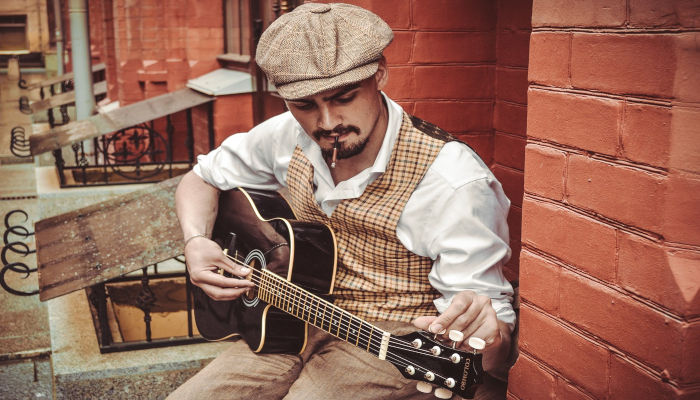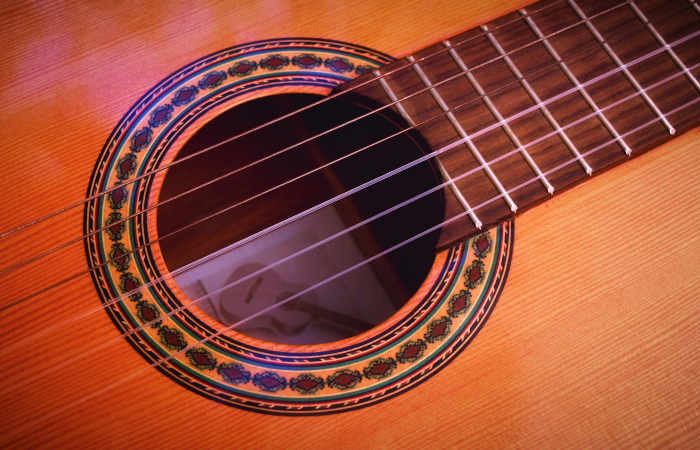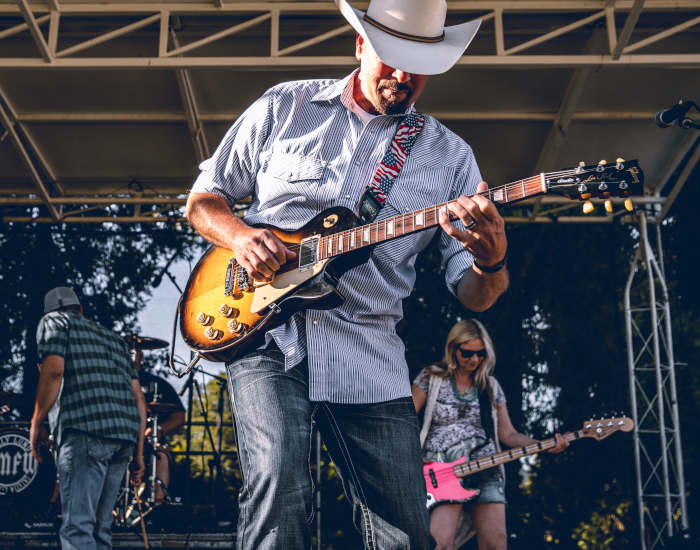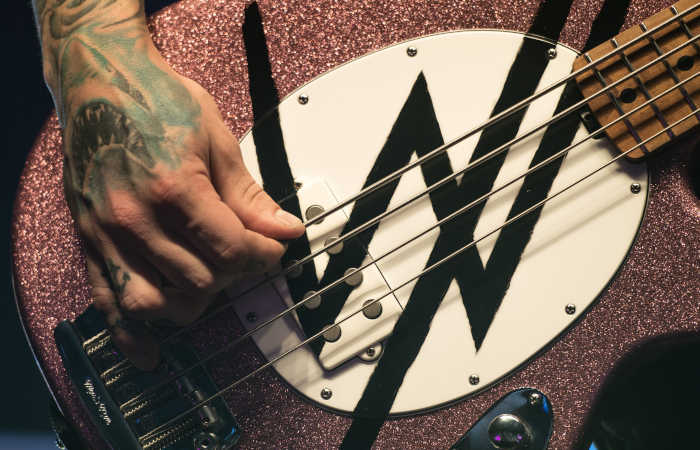
“I want to play the guitar!”
“Which type of guitar?”
“What!? Which types of guitar are there!?”
The answer to this question is, well, several different types! Which one is right for you depends on various factors, which we explore in detail below. In short though, your choice should mostly depend on what kind of music you primarily want to play.
An electric guitar isn’t any more suitable for working towards classical guitar exams than a flamenco guitar is suitable for joining a death metal band (although that sounds like an interesting band!).
Let’s begin by looking at the main differences between common guitar types, before exploring each type in detail.
Main differences among guitars
Different guitars are suitable for widely different music genres and styles of play. They can also vary significantly in price range. But there are several common physical characteristics that help define different types of guitars.
Acoustic vs. electric
Put very simply, the difference between acoustic and electric is that an electric guitar is one that can be plugged into an amplifier via a cable. Whereas an acoustic guitar cannot.
Having said that, there are “electro-acoustic” guitars, of course. But these are very much acoustic guitars that can be amplified rather than regular electric guitars.
Broadly speaking, musical style and genre determine the use of one over the other. Acoustic guitars are the guitar of choice for “softer” musical styles, such as folk or singer-songwriter style. Electric guitars are the guitar of choice for heavier styles like rock and metal.
In between, styles like blues, pop, indie and jazz, you’ll often see acoustics and electrics used more interchangeably, or even a band with two guitarists, one playing each.
Perhaps the most direct route is to study the five or so bands or artists you’d most like to emulate and determine if the guitarist plays acoustic, electric or both. There you’ll find an answer!
Whether a guitar is acoustic or electric typically does not affect its price. It’s more accurate to say that within each “type” there is a comprehensive range of quality and price.
String type – nylon vs. steel
Nylon strings offer a softer, warmer sound, slightly more harp-like than the brighter, more twangy sound offered by steel strings.

Certain types of guitars tend to have nylon strings, while others tend to have steel strings. So your guitar choice will usually determine which strings are most appropriate.
For example, classical and flamenco guitars will typically have nylon strings, whereas acoustic and electric guitars will have steel strings.
Although people have tried switching between nylon and steel strings at times to create a certain effect, anything authentic sounding follows the norm!
Solid-body vs. hollow-body guitars
Usually these terms are discussed in relation to different types of electric guitar.
The solid-body is, as it sounds, a guitar with a body made of one solid block of wood, such as the iconic Fender Stratocaster or Gibson Les Paul.
The hollow-body is a hollow wooden body, and the semi-hollow is a hollow-body with a block of wood running through the middle.
Hollow-bodies are usually larger in size. They generally sound louder when un-amplified, and when amplified have a warmer, deeper sound. Though they can also be prone to excess feedback.
Most guitarists have a preference for either solid- or hollow-bodied instruments. There’s really no substitute for trying out both.
String count – 6-string, 7-string, 8-string and 12-string guitars
Six is the typical string count for a standard acoustic, electric or classical guitar.
7-string and 8-string guitars are typically used for genres and sub-genres of metal. The additional strings may be lower than a standard guitar’s lowest string, meaning that the musician can achieve very low notes to make tunes and riffs sound suitably heavy!
A 12-string guitar can be electric or, perhaps more commonly, acoustic and has a very distinctive sound. This sound could be described as rich, twinkly and full. A 12-string is usually employed for this specific sound and effect in rock, pop and folk music.
A 12-string is usually something supplementary (i.e. not a guitarist’s main instrument but something they’ll add to a recording for texture or effect).
Guitar types
Let’s explore the common types of guitar in detail. For the sake of making this article as accessible as possible to beginners, I’ve omitted some of the more obscure and very specialized types (e.g. the harp guitar and chitarra battente).
1. Acoustic guitar
The acoustic guitar is among the most widely recognized, owned and played instruments in the world.

It’s a staple instrument traceable back to the medieval lute and beyond and can be heard in a huge portion of studio recordings and live bands. It also allows singers to self-accompany with ease, on-the-go.
It’s prevalent in pop, rock, folk, indie, blues, jazz and other genres. And some fantastic, iconic musicians have played acoustic throughout the years, from Chet Atkins and Bert Jansch, through Eric Clapton and James Taylor, to modern masters like Tommy Emmanuel.
This is a 6-string guitar, often in standard tuning (EADGBe), usually made of wood and with a hole in the body, underneath the strings, to create natural acoustic amplification.
The strings are usually a little larger than an electric guitar’s, and a little further from the neck (a “higher action”). This can make the acoustic slightly less accessible than the electric guitar. However, this is countered by the fact that so many accessible simple pop, folk and rock songs are acoustic-based.
Should you buy an acoustic guitar?
Yes! (There’s a guitarist speaking!) If you want to play the guitar, you like a lot of acoustic-based music, such as the styles mentioned above and you see acoustic guitars being played by the artists you’d like to emulate, then yes!
Expect to pay at least $150 (and probably a bit more) before the options become remotely acceptable and playable. If budget allows, $200 will get you something nice to get started with, and generally speaking, price is a decent indicator of quality for guitars.
Guitarists are a community and word spreads fast. If a $500 guitar wasn’t worth it, it wouldn’t sell a whole lot!
There’s no substitute for being able to try out a guitar before committing to owning one. So do that if you can. When you find something you like, whether in person or online, and you have the funds and 10 minutes per day to commit to practice, then go for it!
2. Electric guitar
The electric guitar is undoubtedly one of the coolest instruments in existence. Like the acoustic, it’s among the most recognized, owned and played instruments in the world.

It originated in the United States, around 90 years ago. It’s a staple instrument in most live bands. And apart from sharing a focal place alongside acoustic guitars in pop, rock, folk, indie, blues and jazz, electric guitar also plays a key role in metal, funk and punk music too.
Iconic masters of the instrument have included Jimi Hendrix, Jimmy Page, Eric Clapton, Stevie Ray Vaughan and many others.
This is a 6-string guitar, often in standard tuning (EADGBe), usually made of wood (either solid or hollow body as discussed above) and requiring amplification via an amplifier, to which it connects via a ¼” jack cable.
Whilst noise concerns and the sense that the acoustic guitar is somehow “purer” can put parents of young aspiring guitarists off the electric guitar, its usually slimline shape, low action and “cool” status make it a great starter instrument.
Should you buy an electric guitar?
Yes! (Guitarist speaking again! Buy them all!)
On a serious note, it’s important to recognize that cheap electric guitars are usually worse than cheap acoustic guitars. Perhaps that’s because there are more things that can go wrong, as opposed to an acoustic being essentially a block of wood! (A bit reductive maybe, but the point is valid).
Ask trusted friends, colleagues and band members, have a look around, do your research and get your hands on a few options in person to test them out if you can.
An electric guitar is the one for you if that’s the one your favorite artists or their backing bands use. And it’s absolutely the one for you if you love metal, heavy rock, funk or basically any kind of blistering lead guitar solo!
At the lower end, $200-300 will get you something nice to start with, and remember, price is a good indicator of quality.
While $500-600 isn’t cheap, it is the rough entry point for Fender Stratocasters and Telecasters, guitars that will last a lifetime. So you may end up spending the same amount anyway if you start cheap and then later upgrade to a nicer model.
As with any guitar, make sure you have the funds and 10 minutes per day of practice time to commit.
3. Classical guitar
The classical guitar is a beautiful, noble instrument, mainly used for composing, performing or recording classical music. This may be music written for classical guitar, adapted from other instruments, arrangements of orchestral pieces or even old pieces for lute.

The classical guitar is closer to an acoustic than an electric. In fact, a classical guitar is essentially an acoustic with nylon strings. Whilst it’s not ideal, acoustic and classical guitars can be used interchangeably, if needed, in a way that electric and classical guitars can’t.
Austrlian guitarist John Williams, stands out as perhaps the most famous classical guitarist of all.
The classical guitar has six nylon strings and is usually in standard tuning (EADGBe) and made of wood (hollow body). The classical guitar is also almost always played fingerstyle (i.e. plucked with fingers and thumb, rather than using a plectrum or flatpick).
The classical guitar is often chosen by parents as a first instrument for their children because it’s a great compromise. The child gets the “cool” guitar-player status. And the parent appreciates the sense of formality, dignity and tradition offered by the classical element.
Should you buy a classical guitar?
You’ll know if it’s a classical guitar you should buy, rather than any other type, because your ambition will be to play (probably solo) instrumental, classical pieces.
Whether these are historical or modern pieces, composed for guitar, lute or otherwise, this is still an aim distinct from playing pop songs or joining a rock band.
Anything $200 or more will get you a suitable starter option. As always, the more you can spend the better, within reason. But if you’re at all uncertain, there’s no need to spend more than around $300.
Ensure you have a bit of daily practice time to commit before making a purchase to be sure that it’s worthwhile!
4. Flamenco guitar
Flamenco is a musical style of Spanish origin, famed for its speedy, aggressive guitar work. It has been made famous by guitar legends like Paco de Lucia.

A flamenco guitar isn’t vastly different from a classical guitar. It’s tuned the same (EADGBe). And in fact, these two are far more closely related to each other than either is to any other guitar type.
You could certainly get by playing classical on a flamenco and vice versa. However, if you do have a clear specialism between the two styles, acquiring the correct instrument is key.
Flamenco guitars use different woods on their backs and sides to generate a louder, sharper sound. They also have much lower actions (strings closer to the fretboard) for the style’s characteristic speedy playing.
Should you buy a flamenco guitar?
Well, do you want to play flamenco guitar music? Have a listen to it and compare it with classical guitar (and other styles, for that matter).
This is not one of the cloudier distinctions, like between pop and soft rock, for example. This is a highly distinctive and specialized style, so you probably already know if you want to be a flamenco guitarist or not!
The bottom-end price point for a decent starter flamenco guitar is $200-$250. And $400 or more will buy you something great that’ll last you decades.
5. Bass guitar
The bass guitar is still widely considered a guitar, as opposed to other stringed instruments like the banjo, mandolin or ukulele. But it has certain key features that make it a different proposition to the other guitars mentioned here.

Unlike other guitars, which have six or more strings, a bass typically has four strings. Bass strings are also noticeably heavier and thicker, giving the bass its characteristic sound.
A bass guitar plays an octave lower than electric, acoustic and classical guitars. Basses are tuned E, A, D, G, just like the first 4 strings of a guitar, but an octave lower.
A simple way to think of the role of a bass guitar is that it covers a band’s lower notes, while one of the other guitar types above covers the higher notes. The bass is considered part of the “rhythm section” working together with the drums to create a music’s “groove” over which melodies, solos and vocals can soar.
Bass guitar is featured in just about every band and recording ever! But it’s known to have an especially predominant role in styles like funk and jazz, where expressive pioneers such as RHCP’s Flea, and Jaco Pastorius have transported bass playing to creative new heights.
The bass can be played with fingers, a plectrum/flatpick or even slapped in a slap/pop style that generates a very distinctive funky sound (think of the Seinfeld theme tune!).
Should you buy a bass guitar?
The question really is this: do you want to play rhythmic, funky, grooving low notes that interweave with the music’s drums/percussion and be driving the music forward? Or do you want to be playing more lyrical chords and melodies on top of a tight rhythm section?
There’s no reason you can’t do both, of course –plenty of guitarists also play bass and vice versa. But here we’re talking about your first and main instrument.
As always look further into this. What role does the bassist play in your favorite bands? Can you try playing a bass? Watch some live performances and see what excites you most.
$250 upwards will buy you a great durable starter bass that will last you at least those first few years. Make sure you’re committed to regular practice before making that investment.
Conclusion
In summary, some common points apply regardless of guitar type:
- The styles you want to play determine which guitar type you should buy
- Around $200 is a sensible entry point for most guitars
- Higher price generally equals better quality
- Only spend what you can afford!
- Research to find the best options within your budget
- Ensure you have time to commit to practice before buying
- Seek advice, watch bands and try various models to help decide
Whatever guitar you choose, enjoy yourself and practice hard for good progress!
